

Will Hershey is playing hardball. He flat-out rejected $100,000 and shrugged at $250,000. Fine, I say. What if someone offered you $500,000?
“Hold on,” he says. “Let’s take a step back. I don’t own the ticker.”
Wait, what? That’s not what I’ve heard.
It’s late spring in New York, and the latest bout of Reddit-fueled craziness has hit the market. A source tipped me off that Roundhill Investments -- Hershey’s firm — is sitting on surely one of the hottest assets on Wall Street: It owns the ticker MEME, and is just deciding how to cash in.
“We have it reserved at an exchange,” Hershey says. “It’s not ours to sell.”
Which is a shame, because a good ticker — the set of letters under which a security trades — is a rapidly appreciating commodity. In fact, Hershey had already been approached late last year by a company offering $250,000 for another of Roundhill’s. So I got curious about what it would take for someone to pry MEME from his grasp.
In the end, nothing would. This week, the firm filed to slap the ticker on its own ETF, one that will screen stocks for social media activity and short interest. Turns out these four letters were too precious to part with.
That’s understandable. Research shows stocks with tickers that are actual English words enjoy advantages like lower spreads and greater liquidity. But crucially, they’re also more popular with less-sophisticated investors.
It’s a potential game-changer now the retail crowd is driving as much as a quarter of U.S. equity trading volume, and it's a behavioral quirk that’s especially important for funds.
While the nature of a company easily defines a stock, one big basket of shares can easily look a lot like the next. But add a catchy or memorable moniker, and you get the Invesco Solar ETF (TAN) with more than $3 billion in assets. Take it away, and you have the VanEck Vectors Solar Energy ETF (KWT), which was long ago liquidated after luring just a few million.
To win a slice of the record billions pouring into the saturated $6.7 trillion U.S. ETF universe, therefore, a ticker is all-important.
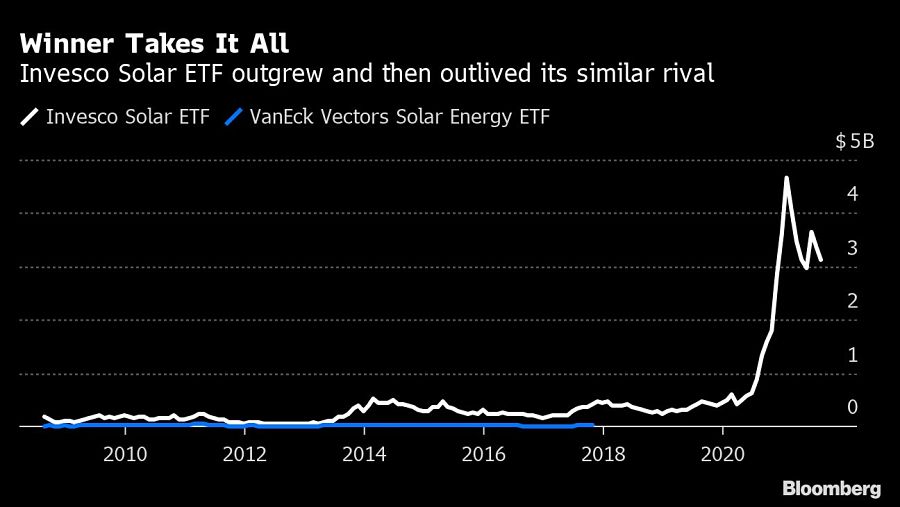
So I persevere with Hershey. You could agree to a price, I say, and Roundhill can drop the ticker and the buyer can reserve it a second after it does. Although I suppose that would create a millisecond risk of someone stealing it.
“Yeah,” says Hershey with a chuckle. “The high-frequency ticker-reservation guys.”
At law firm Morgan Lewis & Bockius, Laura Flores specializes in the regulation of investment vehicles. She’s the person you call if you want to get your ETF registered, and she helped turn the concept behind MEME into the filing that landed with the Securities and Exchange Commission Thursday.
I explain my MEME plan to her, and ask if it’s feasible. She describes it as “technically” legal — which is good enough for me — and intriguingly, says it’s not such an unusual request. Unsolicited approaches for tickers are likely becoming more common.
“It’s probably still kind of a minority situation,” Flores says. “Now that we’re getting into more thematic ETFs where that ticker becomes even more important and recognizable, I think we’re going to see that activity increase.”
An ETF-ticker gray market, fueled by the thematic investing boom? It seems fanciful, considering the complex cocktail of ingredients that combine to make or break any fund.
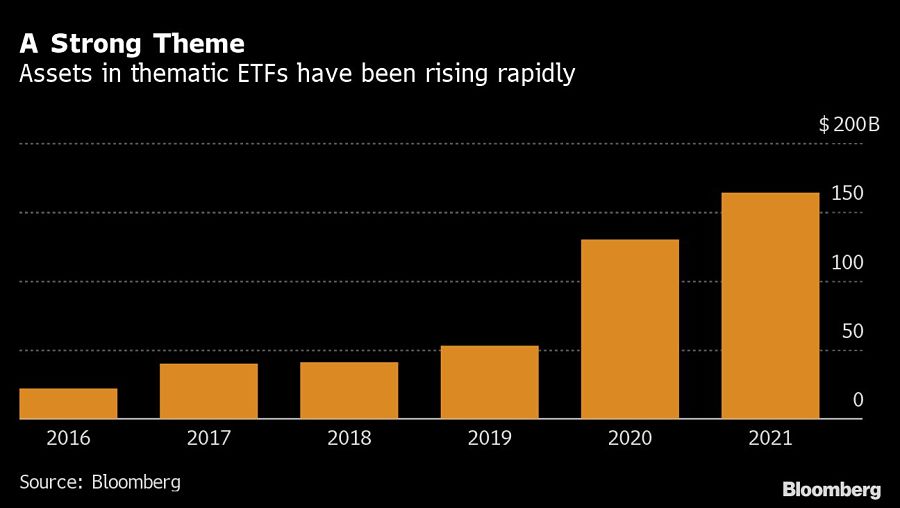
Yet this is a niche where fees and distribution take a back seat to visionary ideas and persuasive pitches. These ETFs, which target hot trends like robotics or electric vehicles, have amassed roughly $165 billion in assets — up from below $50 billion in 2016.
“As we’ve seen an increase of retail trading and investors come into the market, there certainly has been greater appetite for firms — including ourselves — to try and gain access to tickers that may fit in the memorable category,” said Dave Mazza, head of product at ETF issuer Direxion. To date no one has tried to buy a live ticker from him, “but I do know there are back-channel conversations about if someone might have a ticker that you think you might want, is there a possible swap,” Mazza said.
Direxion has been well-placed to surf the thematic wave thanks to products with funky tickers like MOON, WFH and GUSH. But Mazza reckons it’s getting more competitive, and not just because of the fund boom.
“Because there’s been so many IPOs and SPACs, many unique or consumer companies, they’ve taken a lot of great tickers,” he says. Among the stand-outs he cites is COIN, which drew cryptocurrency exchange Coinbase Global Inc. to list with Nasdaq Inc. because the ticker wasn't part of the NYSE pitch.
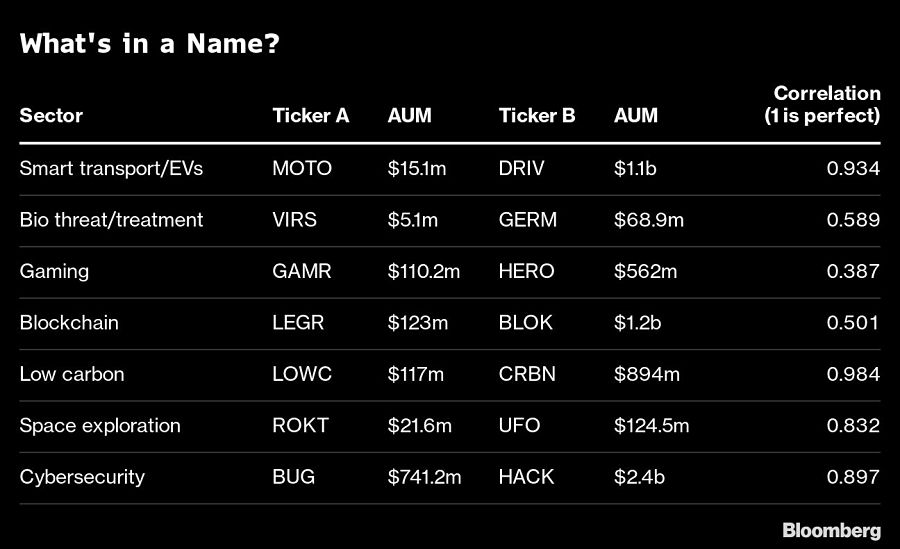
Roundhill is also part of the thematic boom. Having launched in mid-2019, it now oversees about $700 million and has some of the most memorable tickers in the business, including BETZ, NERD and DEEP.
The bid it received out of the blue was from a company preparing to list publicly. They approached Roundhill and made the offer for one of their live tickers.
This is a thornier situation, according to Flores. Issuers have a duty to their investors not to give away the store, so an existing fund’s ticker is not so easy to buy and sell.
“You need to make sure the fund isn’t going to be out any money by losing this ticker,” Flores says. “The adviser has a fiduciary duty to the fund, so the adviser has to justify it.”
In the end, Hershey and Roundhill passed on the $250,000 offer. They decided the long-lasting value of the ticker and the investors it might attract outweighed the one-time cash influx.
If that’s how they view MEME, then anyone looking to secure the ticker may need a new tactic — one that bypasses Hershey.
Rob Marrocco is senior director of listings at Cboe Global Markets Inc. This isn’t where MEME is reserved — that’s at the New York Stock Exchange — but I’m hoping Marrocco will explain how getting a ticker works. Maybe there are loopholes a buyer can exploit.
According to Marrocco, the process looks roughly like this: An issuer approaches the exchange with a wish list, the exchange offers suggestions or input, then assuming the desired ticker is available, it’s allocated to the firm. The issuer then has 24 months to use it or lose it, though this can be extended.
In the case of meme, it seems Roundhill got lucky. Hershey says when the firm first asked for it, another issuer had it reserved, so Roundhill asked to be put on a waiting list. A few days later they got the word: the holder had given it up — it was all theirs.
“We do get releases from time to time because firms have changed their mind,” said Cboe's Marrocco. But far more common is a ticker change after launch, he said.
Picture the scenario: An issuer spends months, probably years, devising a strategy, securing distribution, planning marketing and more. Yet when the fund finally debuts, something doesn’t click. Investors aren’t biting.
Often, issuers conclude it’s the name that isn’t working. Hence the SPDR S&P Kensho Final Frontiers ETF, a fund that invests globally in space and sea exploration, started out as XKFF but exists now as ROKT. The ALPS REIT Dividend Dogs ETF began life as GRI, but is now RDOG.
In total, about 90 ETFs have undergone a name change since the start of 2019, Bloomberg Intelligence data show. Even Hershey has made name adjustments. The Roundhill Acquirers Deep Value ETF launched as DVP with another firm, but Roundhill acquired it and it’s now the far-more satisfying DEEP.
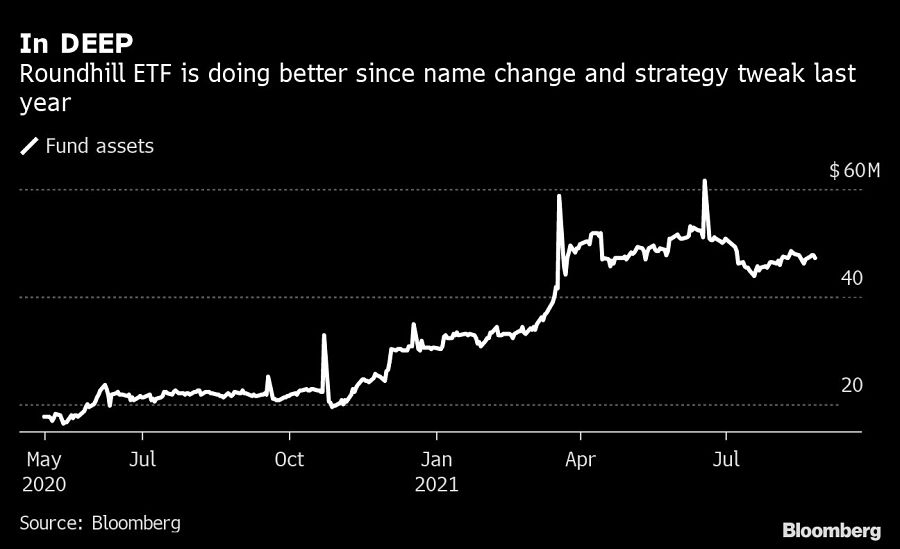
So Roundhill’s chief executive understands the value of a ticker, and for now the reservation is theirs. Back at the negotiating table, I get to the point: How much would it take for him to part with MEME?
“I mean, there’s always a number,” he says. “I guess the question for us to think about is, how big do we think the meme ETF we’re contemplating could become? And then do we think it can reach that level of success without the ticker?”
With meme mania still a force to be reckoned with across markets, the potential is high. Even as economies reopen, businesses restart and people get back to work the number of monthly active users of the Robinhood app more than doubled in the second quarter to 21 million.
Other firms have attempted to tap this day-trading crowd via an ETF. Arguably the closest to being a meme fund is the SoFi 50 ETF. It tracks the 50 most popular stocks on SoFi’s retail trading platform and has surged more than 40% this year — handily beating both the S&P 500 and the Nasdaq 100.
Yet the ETF has only attracted $13 million in flows in 2021, and has assets of just $26 million. Its problem? To some, it’s the ticker: SFYF.
“SFYF illustrates the importance of labeling and positioning for ETFs, with the lack of ‘meme’ in its name or ticker potentially contributing to its lack of inflows,” Eric Balchunas and Athanasios Psarofagis, analysts at Bloomberg Intelligence, wrote in a June note. “That outperformance hasn’t garnered inflows, possibly because investors don’t associate SoFi’s brokerage platform with young day traders.”
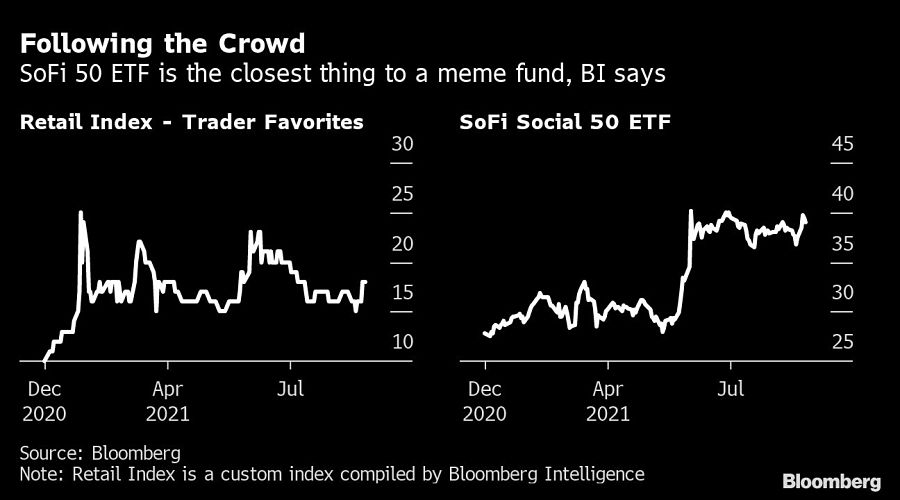
The VanEck Vectors Social Sentiment ETF (BUZZ) has done better, gaining as much as $500 million under management in its first few weeks of trading.
However, despite high-profile backing from day-trading king Dave Portnoy, its flows have stalled — possibly because the fund’s rebalancing schedule means it misses the hottest meme trends.
And that highlights a final aspect of my quest to put a value on the MEME moniker. A ticker is just one aspect of a fund’s success — strategy, distribution, marketing and cost can all come into play in the end.
That means a fund like the iShares U.S. Transportation ETF (IYT) can still be eight times larger than the SPDR S&P Kensho Smart Mobility ETF (HAIL) despite an arguably less-memorable ticker and a fair level of correlation between the two products.
In the end, Hershey doesn’t reveal his hand until long after our conversation — Roundhill filed for the MEME ETF this week. The fund will screen stocks based on their social media activity and levels of short interest, it said, rebalancing every two weeks.
Whether that approach will be more effective at tapping the day-trade army than BUZZ of SFYF remain to be seen, but as far as Hershey is concerned, he already has a head start.
“I honestly think that there’s certain funds that the ticker precedes the fund idea,” he told me. “This is one of them.”

Driven by robust transaction activity amid market turbulence and increased focus on billion-dollar plus targets, Echelon Partners expects another all-time high in 2025.

The looming threat of federal funding cuts to state and local governments has lawmakers weighing a levy that was phased out in 1981.

The fintech firms' new tools and integrations address pain points in overseeing investment lineups, account monitoring, and more.

Canadian stocks are on a roll in 2025 as the country prepares to name a new Prime Minister.

Carson is expanding one of its relationships in Florida while Lido Advisors adds an $870 million practice in Silicon Valley.
RIAs face rising regulatory pressure in 2025. Forward-looking firms are responding with embedded technology, not more paperwork.
As inheritances are set to reshape client portfolios and next-gen heirs demand digital-first experiences, firms are retooling their wealth tech stacks and succession models in real time.
